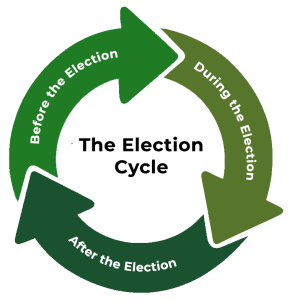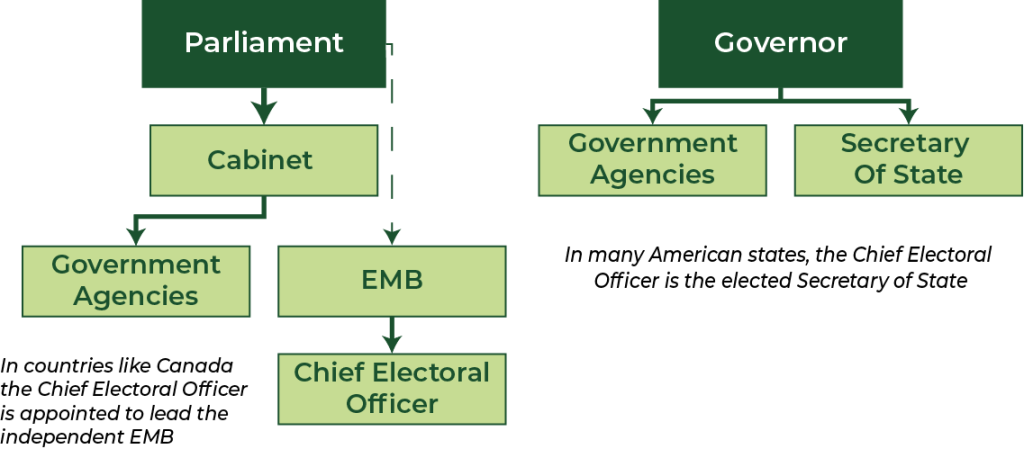5.1 Managing Elections
Elections don’t just happen. They require laws, regulations, resources, and people. In this section, we will examine the different functions that are required to make elections happen. In broad terms, we first want to differentiate between governance – the laws that govern elections, and administration – running the election (James, 2020). Our focus in this section is the administration of elections, typically called election management.
Electoral Management Bodies
The laws governing an election are passed by a legislature, but the implementation of the laws is carried out by an administrative entity called an Electoral Management Body (EMB). While the specific role and functions of EMBs will vary, most are responsible for several core functions before, during, and after elections.

Activity Description
Before the Election
Pre-Election Functions:
- Updating voter rolls
- Hiring poll workers
- Planning and securing voting locations
- Voter outreach and education
During the Election
Election Period Functions
- Registering parties, candidates, and new voters
- Voter outreach and education
- Media communication
- Campaign finance oversight functions
- Preparing ballots
- Voting day!
- Counting votes
- Tabulating results
After the Election
Post-Election Functions:
- Auditing and verifying totals
- Recounts and dispute resolution
- Reporting and validation of official results
Organizational Structure
There are different configurations of EMBs, including those run by government offices and those that operate independently. Countries like Canada and Australia have independent electoral agencies that report to parliament, but they manage their own budget and otherwise operate independently of the executive branch (Catt et al., 2014). The EMB will be ultimately accountable to Parliament, Cabinet, or a legislative committee, but they are insulated from political interference (Thomas & Gibson, 2015). By contrast, elections in the United States are run by government officials at the State or local level. At the State level, the Secretary of State is the official in charge of elections. There are also election officials at the county level, such as clerks, who are responsible for conducting elections. In many cases, these positions are subject to an openly partisan selection process (Ferrer & Geyn, 2024).

Image Description
A diagram compares the structure of election oversight in Canada and the United States.
Left side (Canada):
- The top box labelled “Parliament” leads to “Cabinet.”
- “Cabinet” connects to both “Government Agencies” and “EMB” (Electoral Management Body).
- “EMB” then connects to “Chief Electoral Officer.”
- A caption below states: “In countries like Canada, the Chief Electoral Officer is appointed to lead the independent EMB.”
Right side (United States):
- The top box labelled “Governor” connects to both “Government Agencies” and “Secretary of State.”
- A caption beneath reads: “In many American states, the Chief Electoral Officer is the elected Secretary of State.”
Layers of Responsibility
Unitary states often have one centralized agency that oversees elections, referendums, and initiatives in the country. Conversely, some federal states have a more decentralized system with lower levels of government responsible for elections within their provincial, territorial, and local jurisdictions (Catt et al., 2014).
Management Functions
Managing an election involves several overlapping and connected functions that happen before, during, and after an election (Catt et al., 2014). Next, we will examine some of the important pre-election tasks and responsibilities.

